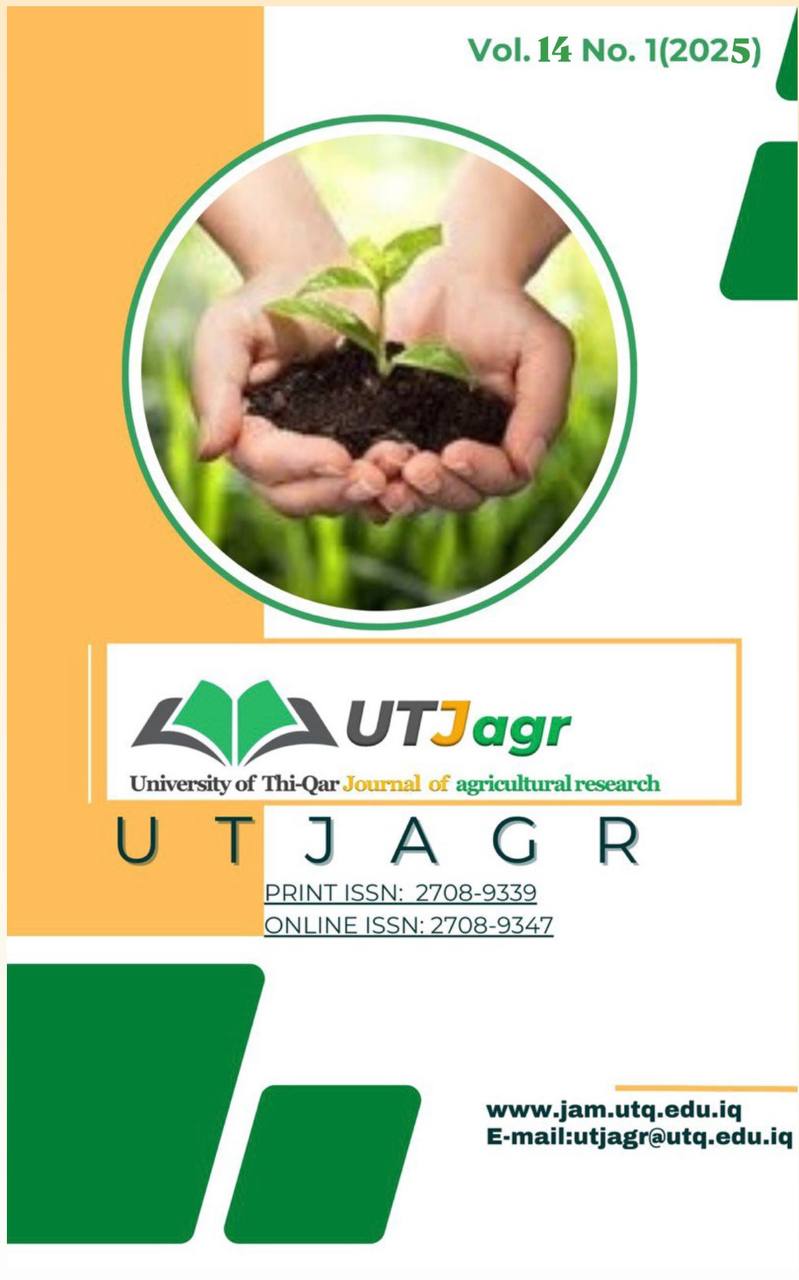Determination of Salicylic and Jasmonic Acids's Median Lethal Concentration and its affecting in Tetranychus urticae Life cycle on Eggplant Leaves
DOI:
https://doi.org/10.54174/yb8zcv77Keywords:
Egg Plant, Jasmonic acid, Median lethal concentration, Salicylic acid, two spotted spider miteAbstract
The current study was conducted to determine the efficiency of salicylic acid concentrations 0, 0.5, 0.75 1mM and jasmonic acid concentrations 0, 5, 50 and 100μM in the adult T. urticae life stages. In addition to determining the median lethal concentration for both acids. This study was applied using the eggplant leaves under laboratory conditions. The results showed that the salicylic acid concentrations significantly influenced the adult longivity and life cycle of the mite T. urticae. The control treatment recorded the highest adult longivity and life cycle periods of 10.33 and 18.67 days, respectively. In contrast, the adult longivity decreased to 7 days when treated with a 0.75 mM concentration. While exposed to 0.5 mM of acid, the average life cycle period scored 12.67 days, significantly different from other salicylic acid concentrations. The lower acid concentrations were more effective in shortening the adult longivity and life cycle. The statistical study revealed the substantial impact of different concentrations of jasmonic acid on the adult longivity, egg stage period, and life cycle of the mite T. urticae. However, the control group registered the longest average adult longivity and the shortest egg stage period, with values of 10.33 days and 1 day, respectively. Moreover, jasmonic acid is most effective at decreasing the adult longivity, with the individual rearing on leaves that treated with 100µM of jasmonic acid reaching a minimum longivity of 6.33 days. It was also noted that the highest efficacy in prolonging the egg stage period resulted from 50 and 100µM jasmonic acid concentration, reaching a maximum of 2.67 days. Jasmonic acid. The lethal concentration of salicylic acid was found to be 1.53 mM, while the lethal value of jasmonic acid was reported to be 43.75 µM.
As a result of the efficiency of these compounds in influencing pests, this study aimed to determine the several concentrations toxicity of salicylic acid and jasmunic acid in the two spotted spider mite T. urticae's life stages. In addition to calculate the lethal concentrations of salicylic and jasmonic acids on adult Tetranychus urticae, two-spotted spider mites.
Downloads
References
Miyazaki, J.; W. N. Stiller; T. T. Truong; Q. Xu; C. H. Hocart; L. J. Wilson and Iain W. Wilson. (2014). Jasmonic acid is associated with resistance to two spotted spider mites in diploid cotton (Gossypium arboreum). Journal of Functional Plant Biology, 41(7): 748-757. http://dx.doi.org/10.1071/FP13333.
Schouteden, N.; E. Lemmens; N. Stuer; R. Curtis; B. Panis and D. De-Waele. (2016). Direct nematicidal effects of methyl jasmonate and acibenzolar-S-methyl against Meloidogyne incognita. Journal of Natural Product Research, 31(10): 1219-1222. doi.org/10.1080/14786419.2016.1230111.
Fazam, J. C.; G. D. Shimizu; J. C. de Almeida and A. Pasini. (2021). Mortality of leaf-cutting ants with salicylic acid. Journal of Semina: Ciências Agrárias, Londrina, 42(4): 2599-2606. DOI: 10.5433/1679-0359.2021v42n4p2599.
Tiftikçi, P.; Ş. Kök and İ. Kasap. (2022). The effect of host plant on the biological control efficacy of the predatory mite, Phytoseiulus persimilis Athias-Henriot against two-spotted spidermites, Tetranychus urticae koch on field-grown vegetables. Journal of Crop Protection, 158(106012). https://doi.org/10.1016/j.cropro.2022.106012.
Jokar, M. (2022). Effects of climatic parameters on Tetranychus urticae (Acari: Tetranychidae) populations based on remote sensing in the southeastern Caspian Sea. Persian Journal of Acarology, 11(2): 339-359. DOI: https://doi.org/10.22073/pja.v11i2.71998.
Steinkraus, D. ; J. Zawislak; G. Lorenz; B. Layton and R. Leonard. (2005). Spider mites on cotton in the Midsouth . Univ. of Arkansas. Division of Agriculture Department of Entomology. Research Reports, Pp: 8.
Mothes, U. and K. A. Seitz. (2004). Fine Structure and function of the Prosomal glands of Tetranychus urticae (Acari: Tetranychidae). Journal of Cell Tissue Research, 221: 339-349. DOI:10.1007/BF00216738.
Yu, X.; Y. Zhang; Y. Liu; Y. Li and Q. Wang. (2019). Synthesis and Acaricidal- and Insecticidal-Activity Evaluation of Novel Oxazolines Containing Sulfiliminyl Moieties and Their Derivatives [Research-article]. Journal of Agricultural and Food Chemistry, 67(15): 4224-4231. https://doi.org/10.1021/acs.jafc.9b00657.
Fasulo, T. R. and H. A. Denmark. (2000). Two spotted spider mite, Tetranychus urticae Koch (Arachnida: Acari: Tetranychidae). Entomology and Nematology Department, Florida Cooperative IFAS Extension Services, Institue of Food and Agricultural Sciences, University of Florid, EENY150. p:1-5.
Wang, L.; Y. Zhang; W. Xie; Q. Wu and S. Wang. (2016). Sublethal effects of spinetoram on the two-spotted spider mite, Tetranychus urticae (Acari:Tetranychidae). Journal of Pesticide Biochemistry and Physiology, 132:102-107. doi:10.1016/j.pestbp.2016.02.002.
Kamaloddin, A. ; F. Yaghoub and B. Mohammad. (2020). Control of Tetranychus urticae by three predatory mites (Acari: Phytoseiidae) in a commercial greenhouse rose. Journal of Crop Protection, 9(1): 17-27.
Murase, A.; F. Kazuo and Y. Shuichi. (2017). Behavioural flexibility in spider mites: oviposition site shifts based on past and present stimuli from conspecifics and predators. Journal of Royal Society Open Science (RSOS), 4(7): 1-10.
Kumari, A. and S. K. Singh. (2022). Chapter 18 - Role of plant hormones in combating biotic stress in plants. In: Aftab, T. and A. Roychoudhury (edrs.). Plant Perspectives to Global Climate Changes. Academic Press, Pp: 373-391. https://doi.org/10.1016/B978-0-323-85665-2.00010-8.
Kondo, A. and A. Takafuji. (1985). Resource utilization pattern of the two species of tetranychidae mites (Acarina: Tetranychidae). Journal of Researches on Population Ecology, 27(1): 145-157. https://doi.org/10.1007/BF02515487.
Amiri, B. B. (2008). Efficacy of Bacillus thuringiensis, mineral oil, insecticidal emulsion and insecticidal gel against Phyllocnistis citrella Stainton (Lepidoptera: Gracillariidae). Journal of Plant Protection Science, 44(2): 68-73. https://doi.org/10.17221/531-PPS.
Mehdi, H. M. R.; H. A. Mehdi and N. H. Mohammed. (2017). Chemical and Biological control of two spotted red spider mite Tetranychus urticae (Koch.) on Smake cucumber. Kufa Journal for Agricultural Science, 9(2): 56-68.
Püntener, W. (1981). Manual for field trials in plant protection, second edition. Agricultural Division, Ciba-Geigy Limited, Pp: 205.
Finney, D. J. (1971). Probit Analysis, 3rd Edition. London, Cambridge University press. Pp: 333.
Ahmed, M. M. (2018). The Impact of Resistance Enhancement in Tomato Plants on Tetranychus urticae Life history traits. Acarines: Journal of the Egyptian Society of Acarology, 12(1): 81-86.
Fhaid, K. A. R. (2013). The Effect of Salicylic Acid (SA) on The Biology of The Two Spotted Spider Mites Tetranychus urticae (Koch) (Acari: Tetranychidae) on The Egg Plant. Basrah Journal of Agricultural Sciences, 26 (1): 359-371.
Gerges, S. J. and A. H. Amin. (1987). Medical and veterinary insects and arachnids .College of Agriculture and Forestry. University of AlMosul. Al-Kutub for Printing and Publishing. Pp: 521.
Pulga, P. S.; J. M. Henschel; J. T. V. Resende; A. R. Zeist; A. F. P. Moreira; A. Gabriel; M. B. Silva and L. S. A. Gonçalves. (2020). Salicylic acid treatments induce resistance to Tuta absoluta and Tetranychus urticae on tomato plants. Journal of Horticultura Brasileira, 38(4): 288-294. http://dx.doi.org/10.1590/ S0102-053620200308.
Conrath, U.; G. J. M. Beckers; C. J. G. Langenbach and M. R. Jaskiewicz. (2015). Priming for enhanced defense. Journal of Annual Review of Phytopathology, 53(1): 97-119. https://doi.org/10.1146/annurev-phyto-080614-120132.
El-khayat, E. F.; Abd El-zahar, T. R.; A. M. Z. Mosallam and M. S. A. Elwan. (2021). Comparative efficiency of phenol compounds on certain biological aspects of two species of fruit flies. Journal of Plant Protection and Pathology, Mansoura University, 12(4): 303-306, https://doi.org/10.21608/jppp.2021.165059.
Zhang, P. J.; Y. C. He; C. Zhao; Z. H. Ye and X. P. Yu. (2018). Jasmonic acid-dependent defenses play a key role in defending Tomato against Bemisia tabaci nymphs, but not adults. Journal of Frontiers in Plant Science, 9(1065). https://doi.org/10.3389/fpls.2018.01065.
Warabieda, W. and R. W. Olszak. (2010). Effect of exogenous methyl jasmonate on numerical growth of the population of the two spotted spider mite (Tetranychus urticae Koch) on strawberry plants and young apple trees. Journal of Plant Protection Research, 50(4): 541-544. https://doi.org/10.2478/v10045-010-0089-y.
Rohwer, C. L. and J. E. Erwin. (2010). Spider mites (Tetranychus urticae) perform poorly on and disperse from plants exposed to methyl jasmonate. Journal of Entomologia Experimentalis et Applicata, 137(2): 143-152. https://doi.org/10.1111/j.1570-7458.2010.01043.x.
Nouri-Ganbalani, G.; E. Borzoui; M. Shahnavazi and A. Nouri. (2018). Induction of resistance against Plutella xylostella (L.) (Lep.: Plutellidae) by jasmonic acid and mealy cabbage aphid feeding in Brassica napus L. Journal of Frontiers in physiology, 9: 859-870.
Meriño-Cabrera, Y.; J. C. Zanuncio; R. S. Silva; M. Solis-Vargas; G. Cordeiro; F. R. Ribeiro; W. G. Campos; M. C. Picanço and M. G. A. Oliveira. (2018). Biochemical response between insects and plants: an investigation of enzyme activity in the digestive system of Leucoptera coffeella (Lepidoptera: Lyonetiidae) and leaves of Coffea arabica (Rubiaceae) after herbivory. Journal of Annals of Applied Biology, 172(2): 236-243.
Shivaji, R.; A. Camas ; A. Ankala ; J. Engelberth ; J. H. Tumlinson ; W. P. Williams ; J. R. Wilkinson and D. S. Luthe. (2010). Plants on Constant Alert: Elevated Levels of Jasmonic Acid and Jasmonate-Induced Transcripts in Caterpillar-Resistant Maize. Journal of Chemical Ecology, 36(2): 179–191. Available at: https://doi.org/10.1007/s10886-010-9752-z.
Mao, Y.-B.; W.-J. Cai; J.-W. Wang; G.-J. Hong; X.-Y. Tao; L.-J. Wang; Y.-P. Huang and X.-Y. Chen. (2007). Silencing a cotton bollworm P450 monooxygenase gene by plant-mediated RNAi impairs larval tolerance of gossypol. Journal of Nature Biotechnology, 25(11): 1307–1313. Available at: https://doi.org/10.1038/nbt1352.
De Resende, J. T. V.; R. Matos; D. M. Zeffa; L. V. Constantino; S. M. Alves; M. U. Ventura; N. C. V. Resende and K. Youssef. (2021). Relationship between salicylic acid and resistance to mite in strawberry. Journal of Folia Horticulturae, 33(1): 1–13. Available at: https://doi.org/10.2478/fhort-2021-0008.
Hassan, N.; A. A. R. Rahil ; M. F. R. Mahmoud and S. H. M. Safar. (2020). Controlling Two Spotted Spider Mite Tetranychus urticae Koch on Phaseolus vulgaris L. Using Some Growth Stimulants Versus Acaricide. Journal of Plant Protection and Pathology, Mansoura University, 11(12): 701-704. Available at: https://doi.org/10.21608/jppp.2020.166220.
Pieterse, C. M. J.; D. Van der Does; C. Zamioudis; A. Leon-Reyes and S. C. M. Van Wees. (2012). Hormonal modulation of plant immunity. Journal of Annual Review of Cell and Developmental Biology. 28: 489–521. Available at: https://doi: 10.1146/annurev-cellbio-092910-154055.
Salehipourshirazi, G.; K. Bruinsma; H. Ratlamwala; S. Dixit; V. Arbona; E. Widemann; M. Milojevic; P. Jin; N. Bensoussan; A. Go´mez-Cadenas; V. Zhurov; M. Grbic and V. Grbic. (2021). Rapid specialization of counter defenses enables two-spotted spider mite to adapt to novel plant hosts. Journal of Plant Physiology, 187(4): 2608-2622. Available at: https://doi.org/10.1093/plphys/kiab412.
Sakr, N. (2017). The role of Silicon (Si) in increasing plant resistance against insect pests review article. Journal of Acta Phytopathologica, Entomologica Hungarica, 52: 185–203. Available at: https://doi.org/10.1556/038.52.2017.020.

Downloads
Published
Issue
Section
License
Copyright (c) 2025 Yusra Jamal Talib

This work is licensed under a Creative Commons Attribution-NonCommercial-ShareAlike 4.0 International License.







1.png)

